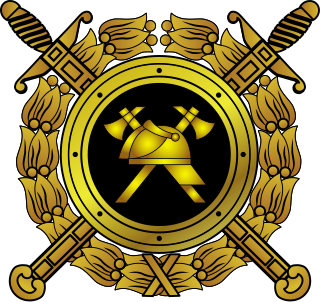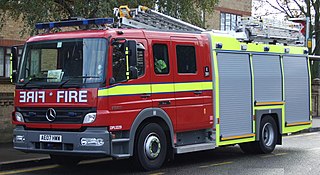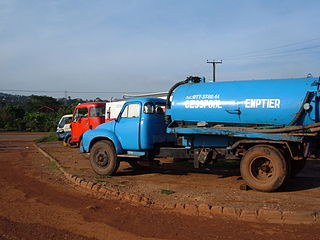
A fire engine is a road vehicle that functions as a firefighting apparatus. The primary purposes of a fire engine include transporting firefighters and water to an incident as well as carrying equipment for firefighting operations. Some fire engines have specialized functions, such as wildfire suppression and aircraft rescue and firefighting, and may also carry equipment for technical rescue.

The Green Goddess is the colloquial name for the RLHZ Self Propelled Pump manufactured by Bedford Vehicles, a fire engine used originally by the Auxiliary Fire Service (AFS), and latterly held in reserve by the Home Office until 2004, and available when required to deal with exceptional events, including being operated by the British Armed Forces during fire-fighters’ strikes. These green-painted vehicles were built between 1953 and 1956 for the AFS. The design was based on a Bedford RL series British military truck.

A water tender is a type of firefighting apparatus that specialises in the transport of water from a water source to a fire scene. Water tenders are capable of drafting water from a stream, lake or hydrant.
This is a glossary of firefighting equipment.

The South Australian Country Fire Service is a volunteer based fire service in the Australian state of South Australia. The CFS has responsibility as the Control Agency for firefighting and hazardous materials and inland waterways in the country regions of South Australia. Its official mission is "To protect life, property and the environment from fire and other emergencies whilst protecting and supporting our personnel and continuously improving."

The Singapore Civil Defence Force (SCDF) is an emergency service in Singapore under the Ministry of Home Affairs that provides firefighting, technical rescue, and emergency medical services and coordinates national civil defence.

Morphett Vale is a southern suburb of Adelaide, South Australia in the City of Onkaparinga. It is the largest suburb in the state, with a population of more than 23,000 and an area of 12.76 km², followed by Paralowie with nearly 10,000 fewer residents. There are approximately 1,000 businesses in Morphett Vale. The suburb is bordered by Sheriffs/Pimpala Road, Panalatinga Road, Doctors/Beach Road, and the Southern Expressway.
The New Zealand Fire Service was New Zealand's main firefighting body from 1 April 1976 until 1 July 2017 – at which point it was dissolved and incorporated into the new Fire and Emergency New Zealand.
The Metropolitan Fire Brigade (MFB), also known as the Metropolitan Fire and Emergency Services Board, was a fire service in Victoria, Australia. The MFB provided firefighting, rescue, medical and hazardous material incident response services to the metropolitan area of Melbourne. The MFB's headquarters were located at the Eastern Hill Fire Station in East Melbourne.

The Auxiliary Fire Service (AFS) was first formed in 1938 in Great Britain as part of the Civil Defence Service. Its role was to supplement the work of brigades at local level. In this job it was hampered severely by the incompatibility of equipment used by these different brigades – most importantly the lack of a standard size of hydrant valve. The Auxiliary Fire Service and the local brigades were superseded in August 1941 by the National Fire Service. After the war the AFS was reformed alongside the Civil Defence Corps, forming part of the UK's planned emergency response to a nuclear attack. It was disbanded in the UK in 1968.

The South Australian Metropolitan Fire Service (SAMFS) is South Australia's government-funded fire service.

A wildland fire engine is a fire engine specifically designed to assist in fighting wildfires by transporting firefighters to the scene and providing them with access to the fire, along with water or other equipment. Most commonly used by the United States Forest Service, there are multiple types of wildfire apparatus which are used in different scenarios. According to the National Fire Protection Association, if the apparatus will be used primarily for outdoor and wildland responses, then it is to be considered a wildland fire apparatus and must conform to NFPA 1906.

Essex County Fire and Rescue Service (ECFRS) is the statutory fire and rescue service for the county of Essex in the east of England, and is one of the largest fire services in the country, covering an area of 1,338 square miles (3,470 km2) and a population of over 1.7 million people.

Russian State Fire Service is the highest fire service body of Russian Federation. A part of the Ministry of Emergency Situations since 2001, the State Fire Service is divided into the Federal Fire Service and the Fire Service of the Federal subjects of Russia.

The M970 Semi-Trailer Refueler is a 5,000-U.S.-gallon fuel dispensing tanker designed for under/overwing refueling of aircraft. It is equipped with a filter/separator, recirculation system and two refueling systems, one for underwing and one for overwing servicing. The tanker is designed to be towed by a 5-ton, 6x6 truck tractor or similar vehicle equipped with a fifth wheel. The M970 can be loaded through the bottom or through the top fill openings. A ladder is provided at the front of the semitrailer for access to the top manhole, and a 4-cylinder diesel engine and pump assembly provides self load/unload capability. The body of the refueler is a 5,000-U.S.-gallon, single compartment, stainless steel tank. The chassis is of welded steel construction and is equipped with full floating tandem axles and a manually operated landing gear. There has been talk of retiring the M970, but a suitable off-road replacement has not been found. The Marine Corps also uses R-9 and R-10 tankers, but they are not capable of off road use. The M970 is a part of the "United States Marine Corps Maintenance Center - Albany, Georgia, USA - An Integrated Enterprise Scheduling Case Study" which is working to upgrade the Semitrailer for future use.

Fire services in the United Kingdom use a variety of fire appliances, which perform a wide range of general and specialised roles and fit into several distinct categories. Contemporary fire appliances carry a multitude of equipment and firefighting media to deal with different types of emergencies ranging from fires, rescues, vehicle extrication, floods, salvage, casualty and trauma care.

A vacuum truck or vacuum tanker is a tank truck that has a pump and a tank. The pump is designed to pneumatically suck liquids, sludges, slurries, or the like from a location into the tank of the truck. The objective is to enable transport of the liquid material via road to another location. Vacuum trucks transport the collected material to a treatment or disposal site, for example a sewage treatment plant.
The Country Fire Authority appliances used throughout the state of Victoria by the CFA are provided through a mixture of State Government funds, money provided through insurance contributions as well as donations from both members of the public and external parties.

The Baltimore City Fire Department (BCFD) provides fire protection and emergency medical services to the city of Baltimore, Maryland, United States. Founded in 1797 and established in 1859, the Baltimore City Fire Department covers an area of 81 square miles (210 km2) of land and 11 square miles (28 km2) of water, with a resident population of over 640,000 and a daytime population of over 1,000,000. The BCFD responds to approximately 235,000 emergency calls annually. There are two International Association of Fire Fighters (IAFF) locals; IAFF 734 for firefighters and IAFF 964 for officers.

Fire and Emergency New Zealand is New Zealand's main firefighting and emergency services body.


























